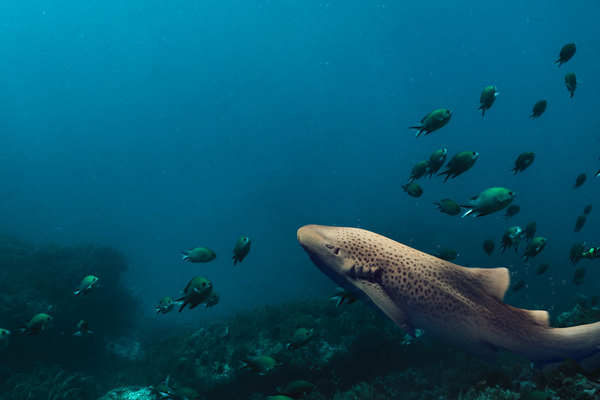Peeling away the prejudices: Shark scanning and taxidermy – first in Australia
In 2017, a Shortfin Mako (Isurus oxyrinchus) was donated to the Australian Museum Ichthyology Collection. After much deliberation about what to do with such a large fish, Australian Museum Taxidermist Katrina McCormick and Simon De Marchi of "Clean-a-Jaw” commenced a 12 month project to preserve, mount and scan the skeleton of this 2 metre long male shark. As sharks are cartilaginous, the task was going to not only be challenging but a first in Australia.
The shark, caught in a shark meshing program (beach net) off Maroubra, was one of the first ever to be put through a CT scanning machine. This provided scientists with a 3D image and insight into the anatomy of one of the most feared and misunderstood animals of the sea.

Shortfin Mako, Isurus oxyrinchus, Ichthyology Collection I.47391-001
Image: Helen Laurendent© Australian Museum Research Institute
Sharks, and their cousins, have been around for 400 million years and yet we still have much to learn about them. In that time, they have not changed but designed themselves to perfection, and stopped there.
The Shortfin Mako is one of the fastest fish in the ocean. It belongs to the family Lamnidae, of which the White Shark (or Great White Shark), Carcharodon carcharias, also belongs. Mako sharks are considered the Great White’s athletic cousin.
Although the Shortfin Mako does not share the same formidable dentition of the White Shark, it makes up for it in speed. It has been clocked at more than 32 km/h, however they are capable of achieving bursts of up to 70 km/h. Shortfin Mako sharks have also been observed leaping out of the water, capable of reaching heights of up to 9 metres. The Shortfin Mako can grow up to 4 metres in length and weigh as much as 400 kg, with females typically being larger than males.
In terms of a shark’s skeleton, it is composed of cartilage and not bone, as ours is. Cartilage is the substance that our noses and ears are composed of, and while not as hard as bone, it is incredibly strong and resilient. There are areas of the shark’s skeleton where the cartilage is calcified, giving it strength and agility. This allows the shark to be able to turn and twist with great ease underwater. This is evident once their skeletal structure is exposed.
While dissecting the shark, a number of discoveries were made. A stingray barb was found embedded in the vertebral column near the caudal fin (tail); a leatherjacket spine in the gum (near the jaw); and a longline hook in its stomach. The fish had survived much adversity before meeting its end in a beach net.

Shortfin Mako, Isurus oxyrinchus, Ichthyology Collection I.47391-001, adapted by Simon De Marchi
Image: Helen Laurendent© Australian Museum Research Institute
Some 400 different species of shark live in the world’s oceans, with a few extending into fresh water. More than 182 species can be found in Australian waters. Shortfin Mako sharks are listed as “vulnerable” by the IUCN Red list, indicating there are some serious threats to this shark from overfishing and excessive commercial catches. Most Mako sharks are caught by commercial long-liners targeting other species such as tuna, marlin and other pelagic fish.
The shark’s important role in the ocean cannot be over-emphasised. It is vital that we are aware of their vulnerability to overfishing and take necessary steps to ensure this beautiful shark will still be around for generations to come.
Amanda Hay, Technical Officer, Ichthyology, Australian Museum Research Institute
Claire Vince, Media Advisor, Australian Museum
References:
Cavanagh, R. D., Kyne, P. M., Fowler, S. L., Musick, J. A. and Bennett, M. B. (2003) The conservation status of Australian chondrichthyans: Report of the IUCN Shark Specialist Group Australia and Oceania Regional Red List Workshop. University of Queensland, School of Biomedical Sciences, Brisbane, Australia. x + 170 pp. https://www.iucnssg.org/uploads/5/4/1/2/54120303/cavanagh_et_al._2003.pdf
Last, P.R. and Stevens, J.D. (2009) Sharks and Rays of Australia. Second Edition. CSIRO Publishing. Collingwood, VIC.
NSW Threatened Species Scientific Committee (2002) Death of injury to marine species following capture in shark control programs on ocean beaches - key threatening process listing. https://www.environment.nsw.gov.au/topics/animals-and-plants/threatened-species/nsw-threatened-species-scientific-committee/determinations/final-determinations/2000-2003/death-or-injury-to-marine-species-shark-control-programs-key-threatening-process-listing
NSW Department of Primary Industry (2006) Shark Smart. https://www.sharksmart.nsw.gov.au/
More information:
Gibbs, L., Fetterplace, L. and Hanich, Q. (2019) Shark nets are destructive and don’t keep you safe - let's invest in lifeguards. The Conversation. https://theconversation.com/shark-nets-are-destructive-and-dont-keep-you-safe-lets-invest-in-lifeguards-127453
Clean-a-Jaw. Shark Jaws Used by Research Institutes.













